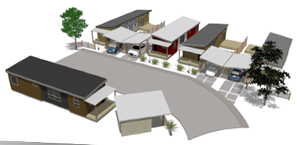Your future tech home could look like this
 The urban environment is daunting, the Mashable reports. In a bustling community of millions of citizens, the mere constraints of having so many people in one place can force innovation to materialize out of sheer need.
The urban environment is daunting, the Mashable reports. In a bustling community of millions of citizens, the mere constraints of having so many people in one place can force innovation to materialize out of sheer need.The development of sustainable, modular and immediate architecture is key in creating a habitable urban environment for a massive population. But a viable option for urban buildings have been around for more than half a century and it’s undergoing a dramatic facelift in order to ride he wave of the future.
A lot of Americans have preconceived notions of prefabricates homes where a synonym of the prefabricated home, “mobile home,” can have a bit of a lackluster imagery. But prefabricated homes have come a long way since their low-cost roots in the 1950s, the Mashable reports.
Ideabox is an Oregon-based company that’s looking to put a spin on modern home design where their goal is to have an efficient, high-tech and sustainable prefabricated home that is not only customized to your daily needs, but also a fraction of the coast of a daily home. They have several projects in the works, and in one of their projects they have partnered with Ikea in creating an eco-friendly neighborhood in Portland.
“There really wasn’t a cool, cutting edge, controlled and cost-effective home situation out there,” Jim Russell said, the lead designer and cofounder of Ideabox. ” Things were too expensive and much larger than they need to be. We thought, t’here’s gotta be a better way.’”
The homes themselves are not only made with an eye toward sustainable resource management (including the use of reclaimed wood and recycled metals), but all of the homes are equipped with the latest in sustainable home technology. From EnergyStar-related products to conservation-oriented heating and air systems, Ideabox homes can come equipped with a floor-to-ceiling green options.
“Every time the word ‘green’ comes up, even today, people think they have to give something up,” Russel said.” But we can design it in the homes and make it really cool without extra cost.”
These homes can either be clustered together, stacked on top of one another or set offshore (Ideabox does have a floating home option for those interested in living on the water.) Further, the row of sustainable prefabricated homes not only saves in home size and efficiency, but it also can be changed and rearranged to accommodate the growth and movement of a metropolis.
“I see potential for the creative of the houses,” Russel said. “Prefab is just another way to build, so if you look at he it in that context, it could have a huge application.”
You can return to the main Market News page, or press the Back button on your browser.

